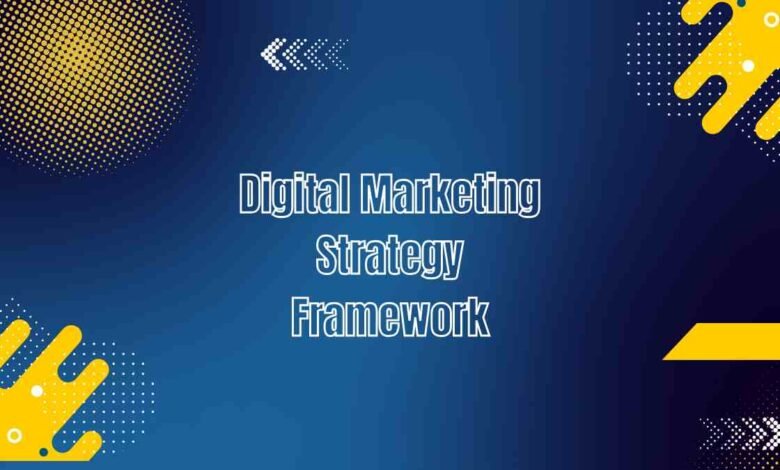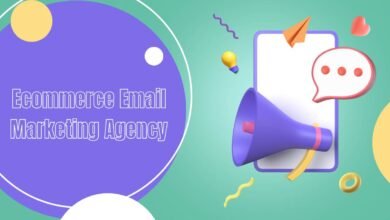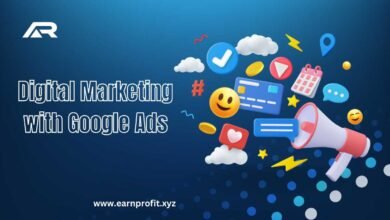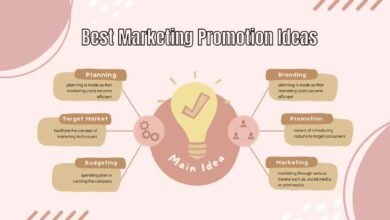Digital Marketing Strategy Framework: How to Build a Winning

Digital marketing strategy framework, businesses must adopt a robust marketing framework to stay competitive. A digital marketing strategy framework is an essential blueprint that helps brands reach their target audience, create engagement, and drive conversions. In this article, we’ll explore the core components of an effective digital marketing strategy framework, focusing on major channels like content marketing, SEO, social media, email marketing, and PPC.
What is a Digital Marketing Strategy Framework?
A digital marketing strategy framework is a structured approach to planning, executing, and optimizing marketing efforts across various digital channels. This framework is designed to align marketing initiatives with business goals, ensuring that every tactic contributes to measurable outcomes. With an organized strategy, brands can effectively engage their audience, increase visibility, and achieve consistent growth.
Why a Digital Marketing Framework is Essential for Success
The digital marketing landscape can be overwhelming without a clear roadmap. By utilizing a structured framework, businesses can approach digital marketing with precision, ensuring each activity works toward specific goals. A well-planned framework also facilitates efficient resource allocation, as it prioritizes tactics that generate the best ROI. Moreover, it enables brands to adapt to changes in consumer behavior, trends, and algorithms.
Must Visit: Earn Profit
Key Parts Computerized Showcasing
A successful digital marketing strategy integrates various components, each contributing to an overarching goal. Below are the essential pillars that should form the foundation of any effective digital marketing framework.
Content Marketing

This component involves creating and sharing valuable content to attract, engage, and retain an audience. High-quality content helps build brand authority, educates potential customers, and guides them through the buyer’s journey. The key to successful content marketing is relevance. Brands should focus on producing content that addresses their audience’s pain points, preferences, and questions. Blog posts, videos, e-books, and infographics are popular formats that can be shared across multiple channels, maximizing reach and impact.
SEO (Search Engine Optimization)
A solid SEO strategy ensures that content reaches the right audience by making it more visible to those actively searching for related topics. SEO is critical because organic search often drives the most traffic to a website, making it one of the most cost-effective ways to attract potential customers. An effective SEO strategy includes keyword research, on-page optimization, technical SEO, and backlink building. By improving SEO, brands can improve their online presence, drive targeted traffic, and achieve long-term growth.
Social Media Marketing
Social media marketing leverages social platforms like Facebook, Instagram, Twitter, and LinkedIn to connect with audiences, build brand loyalty, and drive engagement. This marketing channel allows brands to showcase their personality, share content, and interact directly with customers. Social media also provides valuable insights into customer behavior and preferences, which can inform other areas of the marketing framework. For a successful social media strategy, it’s essential to understand the unique characteristics of each platform. Developing platform-specific content, engaging with followers, and using paid advertising are key tactics that can amplify a brand’s reach and impact.
Email Marketing
With email marketing, brands can nurture leads, promote products, and retain customers through personalized communication. An effective email strategy includes targeted campaigns, such as welcome sequences, product recommendations, and re-engagement emails. Personalization is a vital element of successful email marketing. By segmenting their audience based on demographics, behavior, and preferences, brands can send tailored messages that resonate with recipients. Automated email workflows also allow for consistent, timely communication that helps move customers through the sales funnel.
PPC (Pay-Per-Click Advertising)
PPC advertising is a model in which brands pay a fee each time their ad is clicked. Platforms like Google Ads and social media sites offer PPC options, allowing businesses to reach targeted audiences quickly. Unlike SEO, which can take time to show results, PPC campaigns generate immediate traffic, making it an effective way to gain quick visibility. Successful PPC campaigns require careful planning, keyword research, and budget management. By targeting specific keywords and demographics, brands can maximize their ad spend and increase their ROI. PPC is particularly useful for promoting time-sensitive offers and reaching users who are ready to convert.
Audience Analysis and Persona Development
Understanding the target audience is crucial to developing an effective digital marketing framework. Brands should conduct thorough research to understand their audience’s demographics, interests, pain points, and online behavior. Creating detailed buyer personas helps marketers craft messages that resonate with specific segments. Persona development enables brands to focus on relevant marketing channels, tailor content to meet audience needs, and improve customer experiences. By continuously analyzing audience data, brands can adjust their strategies to stay relevant and effective.
Content Planning and Distribution
A well-thought-out content plan ensures consistency across digital channels. Content planning involves mapping out topics, formats, and publishing schedules that align with the brand’s objectives and audience interests. An effective distribution strategy is also essential to ensure content reaches the target audience. This may include sharing content on social media, email newsletters, and partnering with influencers. Content distribution also requires a blend of organic and paid efforts. For instance, brands can use paid social ads to amplify reach or SEO to drive organic traffic to specific content.
Performance Tracking and Analytics

Monitoring and analyzing campaign performance is essential to refining a digital marketing strategy. Brands should use analytics tools to measure key metrics such as website traffic, conversion rates, email open rates, and social media engagement. These insights reveal which strategies are working and which need improvement. Data-driven insights allow brands to adjust their tactics, allocate resources effectively, and continuously optimize their strategy. Regular performance tracking also helps in identifying emerging trends and new opportunities for growth.
Adjusting the Strategy Based on Feedback
A digital marketing framework should be flexible, allowing brands to adapt to changing market conditions and audience preferences. Regularly collecting and analyzing feedback from customers, team members, and performance data ensures that strategies remain relevant and effective. Based on feedback, brands can adjust their messaging, content formats, and channel selection to improve results. An agile approach to marketing enables businesses to respond proactively to industry shifts and stay competitive.
Integrating Automation and AI for Efficiency
Automation and artificial intelligence (AI) can streamline various aspects of digital marketing, enhancing efficiency and scalability. For instance, email automation can manage large lists with personalized content, while AI-powered tools can analyze data patterns to optimize ad targeting. Integrating automation and AI into a digital marketing framework not only saves time but also provides valuable insights that can improve campaign effectiveness. By embracing technology, brands can focus on strategy and creativity, leaving repetitive tasks to automated solutions.
Conclusion
A comprehensive digital marketing strategy framework is essential for any brand looking to thrive online. By incorporating key components such as content marketing, SEO, social media, email marketing, and PPC, businesses can create a powerful presence across digital channels. From setting clear goals to tracking performance, every step of the framework is designed to optimize resources and achieve sustainable growth. With a well-defined strategy, brands can connect with their audience, build loyalty, and drive lasting success.
Read More: 5G Cybersecurity





